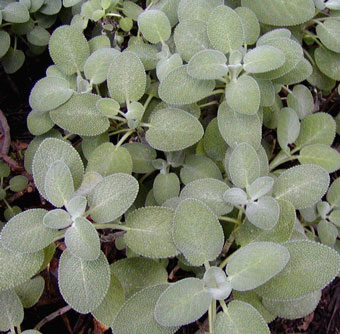Culinary Sage
Salvia officinalis

. . . for holiday dinners and ever-greenery
Common Name: Culinary Sage
Botanical Name: Salvia officinalis
Design Tip: The culinary sage, a customary seasoning for turkey dressing, is a traditional herb garden stable, but can also provide decorative evergreen foliage in ornamental flowerbeds. It is well suited for border edging and geometric plant patterns in contemporary designs or formal parterres.
Form: The silvery green herb provides either an evergreen perennial or a clipped groundcover. All parts of the plant emit a strong scented odor due to the volatile oil contained in the tissues.
Size: An un-groomed plant matures at one to two feet tall and wide.
Grooming: Biannual clippings in spring and fall preserves a neat shape and instigates fresh young foliage, for the best flavor and color.
Flowers: Insignificant blue flowers occur in summer.
Foliage: Two to four inch oval leaves of the silvery-green species vary in shape and size, but all have a rough-textured foliage. Colorful-leafed cultivars tend to be less durable than the solid green species. They include the golden sage 'Aurea', a purple leafed 'Purpurascens' and 'Tricolor' with variegated green, white and purple leaves.
Cultivation: This short-lived perennial is best planted in fall or spring and may need replacing every three or four years. A part-sun exposure and sharply drained alkaline soil is ideal. New plants require evenly-moist soil until roots mature. A mature plant accepts intermittently dry soil, but performs well in cultivated beds with sufficient drainage.
Cold Tolerance: Hardy in USDA Zone 5- 9
Snippets: The name of the genus, Salvia, is derived from the Latin salvere meaning to be saved, referring to ancient beliefs of curative properties. It was also believed to provide wisdom and improve the memory. Sage is a traditional seasoning for all types of poultry and pork dishes. Store dried sage in refrigerator or freezer to preserve the flavor.
Cultivated, photographed and written by
Maggie Ross McNeely in Fort Worth, Texas
All rights reserved